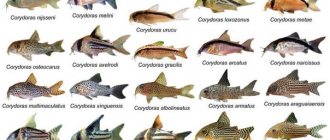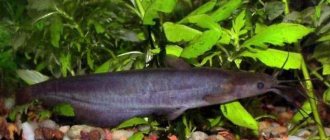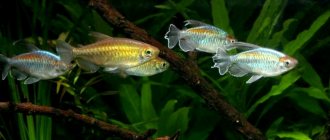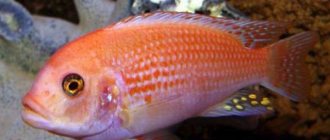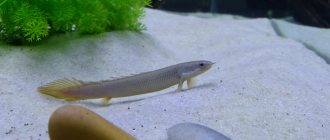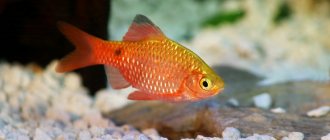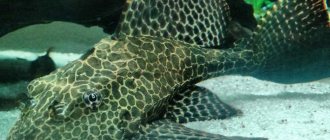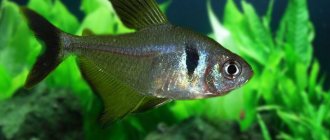Habitat in nature
The natural habitat of all representatives of this species is water bodies in Brazil, as well as Venezuela, Guiana and Paraguay. Astronotus were first brought to Europe almost a century ago, and in Russia such fish appeared a little later, but almost immediately became incredibly popular among aquarists.
It should be noted that the ornamental fish is very successfully acclimatized in the southern part of America, where it is a popular object of widespread sport fishing. Almost all large farms specializing in breeding various types of ornamental fish are closely involved in breeding astronotus, especially such a popular variety as the “red Oscar”.
Breeding and reproduction in an artificial environment
Astronotus tiger reaches sexual maturity at the age of one year. With proper care and maintenance, reproduction occurs naturally in a common aquarium and does not imply the creation of any special conditions for spawning.
It is only necessary to install at the bottom of the aquarium some kind of ceramic houses or other types of shelter intended for spawning. What is surprising is that, unlike most other aquarium fish, Astronotus tiger has pronounced parental instincts. Representatives of this species do not eat their eggs; they care for the fry and protect them until they reach a certain age.
Astronotus tiger is a unique aquarium fish, distinguished by its excellent intelligence and high level of socialization. It is able to recognize its owner and show signs of attention to him, which is extremely rarely observed in other aquarium inhabitants.
Description
Astronotuses belong to the category of fairly large aquarium fish, and in their natural habitat their body length can be 35-40 cm . When kept in aquarium conditions, such an ornamental fish grows to a length of 15-22 cm, has large eyes and head, and is also distinguished by a pronounced and rather convex frontal part. The colors of astronotuses are very diverse. The red decorative variety of astronotus has become widespread. The juveniles vaguely resemble their parents, but have a jet-black color with white streaks and the presence of a small star-shaped pattern throughout the body.
A well-known albino breeding form and very common among most amateur aquarists is the red variety of Astronotus with white fins, which is often called the “Red Oscar”.
Most often, the color of the general background varies from grayish-brown tones to coal-black, with the presence of scattered and large spots, as well as yellow stains of various shapes and sizes, which may have a pronounced black border. The base of the caudal fin is characterized by a large black spot framed by an orange stripe, which resembles the appearance of a large eye. There is an assumption that it was thanks to this very peculiar “eye” that astronotuses were awarded the species name “Ocellatus”, which means “eye-shaped” in Latin.
Varieties of aquarium "peacocks"
Astronotuses come in various shapes and sizes, but they usually differ in color.
Tiger Oscar (classic) – gray with orange or pink spots. It is better adapted to living in captivity than others.
Astronotus albino is white, which is why it got its name. Orange spots are visible on the body. Sometimes they are red. It is also distinguished by pink or red eyes.
Veiled Astronotus - comes in different colors, but is distinguished by long luxurious fins.
Red Oscar is bright red and has white fins.
The listed types of astronotus were bred through selective breeding. Wild representatives of the species are gray, yellow or greenish in color with uneven light stripes and orange specks.
Kinds
Wild fish have a rather modest coloration, a dark shade, against which there are orange spots - on the back and gill valves. There is a black spot on the caudal fin, for which the fish are nicknamed astronotus ocellata.
In addition, wild specimens and selectively bred fish have a special ability to quickly change color at certain moments. This happens when the fish is stressed, starts a fight, or scares rivals away from its territory. Young animals can be distinguished from adults by color - their body is covered with dark and white spots.
There are several forms of astronotus, which differ in color:
- Brindle . It has become a favorite among aquarists because of the unusual, rich color of its scales - there are crimson and orange spots on a gray or brownish background. Fish of this species are purebred and are suitable for aquarium keeping.
- Red . Unlike the brindle, the red astronotus does not have clearly localized spots on the body. This is the most common representative of the breed. Individuals can be burgundy, bright red or reddish in color. Due to the fusion of similar shades, the scales of the fish look iridescent and velvety.
- Albino . These are white fish, but their color is enlivened by filling them with a red or orange tone. Another feature of albinos is their eyes are orange or pink.
- Lyutino . They are similar in appearance to albino astronotuses, but they have a darker coloring, which is especially noticeable in the area of the tail and fins. Lutino is capable of producing pigment spots of green, brown, and black. Their eyes are dark in color.
- Golden Oscar . One of the rarest breed species, individuals of which resemble red astronotus, but instead of orange and red shades, the golden oscar has golden and yellow ones.
- Super ed . Another rare species of the breed, individuals of which are called bloody astronotuses. They can be recognized among other aquarium inhabitants by their bright, uniform coloration throughout the body.
- Veil Oscar . Fish of this breed have luxurious, elongated fins that move effectively while swimming. As for colors, it can be different.
In addition, there are astronotuses with colors of brindle Lutino, sunny lemon, blueberry, and strawberry.
Sex differences
How to distinguish the sex of astronotuses? It is very difficult to distinguish a female from a male. Guaranteed, only during spawning based on the presence of an ovipositor in the female. Breeders usually buy a dozen juveniles and raise them together, thereby allowing the fish to choose a mate for themselves. It is believed that the female astronotus is smaller in size than the male, but this is a relative sign. The real difference is the appearance of the ovipositor, with which she lays eggs. But it turns out to be a vicious circle - since it appears only during spawning. Just look at the photo below to understand how similar they are.
Types of Astronotus
Under natural conditions, there are two types of astronotus: ocellated astronotus and thick-finned astronotus.
Ocellated Astronotus
Ocellated astronotus (Astronotus ocellatus) is also called Peacock's eye or Water buffalo. At the base of the tail fin, the fish has a spot that resembles an eye (hence the name). In nature, specimens of this species reach 24 cm in length; in aquarium conditions they grow to 25-30 cm.
Based on this species, many color variations have been developed. The most popular of them are: red astronotus, blue astronotus, tiger and walnut astronotus. A veiled version of Astronotus with large fins has been developed; several almost colorless variants of Albino Astronotus are known.
Thick-finned Astronotus
The thick-finned astronotus (Astronotus crassipinnis) is the closest relative of the ocellated astronotus. The first mention of the species was at the end of the 19th century and then it was called Acara crassipinnis. The species is rare and poorly studied.
Representatives of the species can grow up to 25 cm in length. The body of the fish is painted in a darker color, with clear vertical stripes across the entire surface.
Reproduction
They become sexually mature at a size of 10-12 cm. Astronotus are bred, as a rule, in the same aquarium in which they live. You need to create several shelters and place large, flat stones on which they lay their eggs.
During courtship, the couple selects a stone and cleans it thoroughly. The caviar is white, opaque, and can change color within 24 hours after spawning. Parents take care of the fry, but as soon as they begin to swim on their own, they can be removed from their parents. Astronotus fry are large and viable. The fry can be fed with Cyclops and Artemia naupilia.
But before you start breeding, think carefully. An adult female can lay up to 2000 eggs, the fry is strong and grows well. This means that you need to feed and care for him constantly. At the same time, selling or giving away astronotuses is not an easy task. The demand for them is small, but the supply is the opposite.
Interesting facts about unusual pets
Astronotuses appeared in Europe recently, in 1934. In Russia, fish were recognized in 1957.
In the USA, astronotuses are used in sport fishing; in this country there are even special farms where they are bred.
Fish are respected in Thailand. Temples, offices and many homes have aquariums and pools in which astronotus live.
Astronotus are predators. If a fly flies over the aquarium, the fish may try to catch it. This threatens her with death, because the pet sometimes ends up on the floor. For safety, the aquarium should be covered.
Like and share the article on social networks if you liked it. Are you a happy owner of astronotuses? Tell us about them in the comments.
Maintenance and care in the aquarium
Keeping Astronotus aquarium fish is quite simple, provided that you provide them with fresh and clean water. An aquarium is a closed system and no matter how big it is, it still needs cleaning and maintenance. Over time, the level of ammonia and nitrates in the water increases, slowly poisoning the fish.
Since they are very sensitive to poisoning by these substances, it is important to change about 20% of the water in the aquarium weekly and siphon the soil. Residues of food accumulate in the ground, rot, and often because of this, the most problems with keeping astronotuses occur.
Remember that astronotuses in the aquarium litter while eating, the remains of food scatter in all directions. For example, they spit out parts of fish, although they eat the same tablets almost completely. So if you provide food such as live fish, then you need to siphon the soil and change the water even more often.
Juvenile Astronotus will live comfortably in a 100 liter aquarium, but when they become adults, they will need 400 or more liters. If you plan to keep a pair for breeding, and even with other large fish, you need a much larger aquarium to reduce the number of fights. Astronotus like water with high oxygen content, but do not like current, so you need to either use aeration or feed water from an external filter through a flute located above the surface of the water.
Since the fish are very large and quite active, make sure that the equipment and decor are installed securely, and even better, have protection. It is better to cover the heaters with large stones or other decor. Oscars can play with the decor by attacking it, but due to their size this can end badly for the decor. If your fish are prone to this behavior, then you can deceive them by throwing some object that will distract their attention from the equipment.
The best soil to use is sand, which they like to dig. Plants are not needed, they will either be dug up or eaten. However, you can try to plant hard-leaved species, such as Anubias, in pots.
And yes, if you are thinking of creating some kind of scape in the aquarium so that everything looks beautiful, then remember - the main thing in the aquarium is not you, but Oscar. Astronotuses will dig up and move everything they consider necessary. It is highly advisable to cover the aquarium, this way you will avoid splashes during feeding and your fish will not jump out.
Options for content:
- Water temperature – 22-26C
- acidity ph: 6.5-7.5
- water hardness – up to 23°
Content
Astronotus is a large fish that loves space. To comfortably keep a pair of astronotuses, you will need an aquarium with a capacity of at least 400 liters. Accordingly, the more fish there are, the larger the volume should be.
Due to their size, fish produce a lot of waste, so water filtration is a must. It is recommended to purchase an external filter, which will not only purify the water, but will also keep this aquarium pest away. Aeration is also necessary to saturate the water with oxygen.
Cichlid is a famous landscape designer. They love to dig and move accessories. To prevent this from happening, you will have to attach everything that can move. They also do not like plants on their territory. The fish will dig up any flora, damaging the roots, or simply pull it out of the ground. The best option would be soil, a couple of driftwood, to which a floating plant with hard leaves will be tied (artificial flora with weights is also suitable), and stones.
soil , buying coarse sand or pebbles. The main thing is that the pebbles do not have sharp corners, otherwise the fish may get injured while digging.
Astronotus do not like
plants on their territory.
The fish will dig up any flora, damaging the roots, or simply pull it out of the ground. The best option would be soil, a couple of snags. Despite its bad character, the fish is very unpretentious. She can be content with average performance and exist comfortably. The only thing you should know is that astronotus prefer warm water , and if the owner allows the temperature to drop to +13, the fish will die. Therefore, +23+28 degrees Celsius should be maintained. As for the remaining parameters, you need to ensure:
- Acidity within 6-7 pH;
- Hardness from 5 to 20 dH;
Once a week it is necessary to replace from 20% to 50% of the water volume, since cichlids prefer fresh water.
Astronotus do not require special lighting . It is important to provide them with conditions close to natural, so LED fluorescent lamps will be sufficient.
The diet of astronotus is very diverse. Since it is a predatory fish, it prefers small fish, shrimp, crustaceans and worms. In order to lure the victim closer, the astronotus lies on the bottom and pretends to be dead. When a curious fish swims closer, the predator quickly reacts and grabs the prey. Aquarium specimens feed on any type of food. Adults eat live fish, bloodworms, grasshoppers and crickets. Astronotus fry prefer frozen food. As for animal meat, the digestive system of fish does not absorb it well, which is why they often experience distress. In addition to meat, fish also need plant food. They eat green peas, spinach and fruits with appetite.
Like all cichlids, the Astronotus fish is prone to overeating. Once a week, it is strongly recommended to arrange fasting days for adults so as not to overload the digestive tract.
diseases are often associated with improper maintenance. The fish has strong immunity, so all infections occur through the fault of the owner.
Astronotus are often subject to hexamitosis due to improper keeping of pets.
Often fish undergo hexamitosis. Erosion covers the head and lateral line of the fish. Astronotus does not eat and swims little. This occurs due to a lack of vitamins, dirty water and inadequate feeding. An urgent change of water, metronidazole, as well as enhanced and fortified nutrition are necessary. They may also be susceptible to infections and parasitic infestations.
Difficulty in content
Although the aquarium astronotus is an interesting and easy-to-keep fish, it is important not to be deceived by its size as a juvenile, as well as its peaceful behavior. Most Oscars are sold at around 3cm in size and are kept in a community tank with other fish at this time. However, don’t be fooled and buy yourself an astronotus for a shared 100-liter aquarium! It grows very quickly, for normal development it needs an aquarium volume of 400 liters or more, and feeding it is quite expensive. In addition, it is a predatory fish that needs to be kept as a pair in a separate aquarium or with large neighbors in a very large aquarium.
But don't be upset. If you are firmly convinced that you want just such a fish, then keeping astronotus is not difficult, and in return you will get a beautiful, intelligent and almost tame fish.
Maturation of eggs and care of offspring
The eggs are left with the parents (they will care for them, but they may also eat them) or they are transferred to a separate aquarium with a volume of at least 20 liters.
If the caviar is moved to a separate place, then a special aeration system is installed there. Add a weak solution of methylene blue to the water. Caviar matures in about 50 hours. After this time, larvae appear. On day 4 they can swim freely in the water. The owner must feed them: first they give them live dust (daphnia), and after a few days they switch to larger food. These can be larvae of various insects, bloodworms, small pieces of beef, earthworms, small live fish.
Remember that fry always develop unevenly, so the aquarist needs to make sure that the large “babies” do not eat the small ones.
We recommend reading
Compatibility of angelfish with other fish
Feeding the Astronotus
In nature, these fish are omnivores, eating a wide variety of foods including: insects, larvae, zooplankton, plants and algae, fish, invertebrates and amphibians.
In an aquarium, these are extremely unpretentious fish to feed, although it is preferable to give them animal food. It is best to feed artificial high-quality food for large cichlids - pellets, granules, tablets. Fortunately, there is now a wide selection of them, from Chinese to European manufacturers. Additionally, provide live or frozen food. They love earthworms and crawlers, but also eat crickets, shrimp, fish fillets, mussel meat, tadpoles, grasshoppers and other large foods. Naturally, they also give them fish, such as guppies or veiltails, but this is best done only if you are completely sure that the fish are healthy and will not carry diseases.
Astronotus are very greedy and insatiable fish, so it is important not to overfeed them, otherwise illness and death may occur.
At one time, cichlids were fed mammalian meat, but this should now be avoided. The fact is that due to the high content of protein and fat in such meat, it is poorly digested by fish, leading to obesity and degeneration of internal organs. It is better to feed the same beef heart once a week, so as not to overload the fish.
Interaction with neighbors
It is better to keep astronotuses alone, but you can place fish of certain breeds with them. These may be large southern and central American cichlids. They are also compatible with parrots, arowanas, Managuan and eight-striped cichlid fish, large plecostomus, and also with black pacu. But keep in mind that not all individuals get along equally well with Astronotus. The nature of the individual Oscar plays a significant role.
If other fish are added to the astronotus, then all the pets are placed in the aquarium at the same time. This way they won't fight and take space from each other.
Meat lover's diet
Feed your astronotus a variety of foods. They are given:
- bloodworm;
- fish fillet (sea);
- earthworm;
- ox heart (raw) in small pieces;
- food that is designed for cichlids.
Astronotus are voracious pets and are prone to obesity. They only need to be fed once a day. Also, once a week the fish should have a fasting day.
It is not advisable to feed astronotus beef more than once a month; this will help reduce the risk of the fish developing obesity and speed up the process of puberty.
In addition, periodically feed tadpoles, barnacles, shrimp or squid. Everything is raw. For young animals, food is cut into pieces; adults can be given whole small food. It is better to take special food as the basis of the diet, and feed the rest as supplementary food 1-2 times a week. Select portions such that the astronotuses completely eat the food in 5-7 minutes. There should be no leftovers.
While keeping them, pamper your pets with small pieces of mashed black bread, ground rolled oats, pieces of spinach, and lettuce leaves.
We recommend reading
Why do guppies die in an aquarium?
Astronotus diseases
Non-contagious:
- suffocation;
- gas embolism;
- lack of vitamins;
- lack of minerals;
- obesity;
- overheat;
- stress;
- injuries and others.
Contagious: hexamitosis. Sores, often covered with mucus, on the body and especially on the head of the fish. Their appearance is caused by the activity of the Hexamita bacterium in the intestines. The causes are not fully known. The most likely: a lack of vitamin C due to improper feeding (exclusively beef or pork) or the use of activated carbon for filtration. It is treated by adding metronidazole or other medications to the food, as well as a balanced diet.
Prevention of infectious diseases of astronotus
To avoid the appearance of bacterial, viral, fungal and parasitic diseases, new individuals must undergo a 5-day quarantine in an isolation facility. Soil (especially from natural sources), algae (both live and artificial) and decor must be pre-treated. By boiling or placing it in a pale pink solution of potassium permanganate for several minutes. Under no circumstances should these predators be fed river fish. She is a carrier of diseases that are dangerous to them.
Breed diseases
Astronotuses are unpretentious and fairly disease-resistant aquarium fish. Despite these characteristics of the species, they can suffer from both common and infectious diseases. These are mainly fungal or bacterial infections.
Infections by bacteria, as a rule, occur in conditions of improper maintenance, as well as inadequate nutrition, as a result of which immunity is reduced. In the case of such diseases, wounds, cavities and depressions appear on the fish’s body. As a rule, this is the result of a lack of vitamins and minerals, which is associated with a poor diet and dirty water, which is rarely replaced with clean water. To treat bacterial diseases, it is necessary to revise the diet, making it more nutritious and balanced, and also using Metronidazole.
Important information! The average life expectancy of this species is 12 years. With proper care, balanced nutrition, and preventive measures, these aquarium fish can live up to 15 years, or even more.
In cases of parasitic or infectious diseases, it is necessary to practice quarantine measures. It is not recommended to introduce river fish into the diet of astronotus, which can serve as a source of various parasites. Before equipping the aquarium, the soil that is intended to be placed in the aquarium should be subjected to heat treatment. Vegetation and other elements, as well as decor, are treated with a weak solution of potassium permanganate.
Compatibility with other fish
It is best for these fish to live separately only with their relatives. Moreover, the aquarium should have a volume of 400-500 liters, this will eliminate the fights that astronotuses start during spawning. In a spacious container, the inhabitants feel more relaxed; it is important for them to swim freely.
Experienced aquarists prefer to install 2 tanks at once - one for astronotuses, the other for other fish. If this is not possible, then the following candidates can be considered as neighbors (provided that the aquarium has a volume of at least 1000 liters):
- Geophagus - non-conflict, calm fish from the cichlid family;
- characin metinnis - unpretentious and peaceful aquarium inhabitants;
- ancistrus (catfish) - small catfish that hardworkingly and painstakingly clean up the “mess” that sloppy cichlids make and eat the remains of food falling to the bottom.
When choosing companions for astronotuses, you should listen to the recommendations of experienced aquarium specialists:
- astronotus and small fish are not the best combination; larger cichlids will consider them as food;
- It is desirable that astronotuses end up in an established aquarium with other inhabitants, otherwise they can behave “like sole owners”, aggressively chasing away the “new settlers”;
- it is important to provide the aquarium with vegetation, driftwood, and stones - this will enable bottom dwellers to hide from overly territorial neighbors and lay eggs;
- It is advisable to keep fish of approximately the same size in one tank - they have a better chance of getting along in the same area.
If possible, it is recommended to house these gorgeous cichlids separately. They will be quite enough to decorate the tank.
Character and behavior in an artificial habitat
Astronotus tiger, by its nature, is a predator, and also defends its right to territory. Therefore, in a small aquarium it is best to keep a couple of representatives of this species of different sexes. In large artificial reservoirs with a large amount of free space, the proximity of tiger astronotus with arowana, black pacu, plecostomus, chain-mail catfish and other large-sized fish is allowed.
Astronotus, as a rule, show aggression towards small aquarium fish, considering them as potential prey, so living together in the same tank is highly not recommended. In general, to reduce the level of aggression, it is recommended to introduce young fish into the aquarium, preferably still in the fry stage.
However, the tiger astronotus is such a unique and interesting creature in its behavior that it alone can easily replace other aquatic inhabitants.
In nature, this fish is the only one with a sharp mind and good memory, capable of remembering and recognizing its owner.
Moreover, gradually the tiger astronotus becomes so attached to its owner that it spends hours carefully watching what is happening in the apartment, and is especially fascinated by the cleaning process. And when a person approaches the aquarium to feed the fish or for some other purpose, the astronotuses rise up and swim as close as possible, as if greeting their beloved owner.
Some fish adapt and socialize so well that they even begin to accept food from hands and allow themselves to be stroked. True, experts still recommend being careful, because this predator has fairly large teeth and unpredictable behavior. Therefore, if he doesn’t like something, he can bite, causing quite serious injury.
Despite its predatory nature and innate hunting instincts, tiger astronotus, when properly maintained, with enough free space and wisely selected neighbors, behaves quite calmly and peacefully, extremely rarely coming into conflict with both its relatives and other aquarium inhabitants.
Owner reviews
According to experienced aquarists, in order for astronotus to feel as comfortable as possible, it is necessary to create many places where the fish can hide.
Representatives of the order Perciformes and the cichlid family love to independently rebuild the entire interior decoration of the aquarium according to their preferences, so they often rearrange decorative elements, including driftwood and stones. In this regard, sharp or dangerous decorations should be completely excluded.
As the practice of keeping astronotuses shows, it is advisable to use bloodworms for feeding young animals, while adults need large live food. Earthworms should first be cleaned of soil and dirt in water. In addition, minced protein is well suited for feeding cichlids, which is prepared from lean beef, squid meat, pieces of liver and heart, and then frozen.
It is important to remember that astronotus are predatory fish, and therefore should be provided with food that is as rich in proteins as possible . Currently, pet stores offer quite a few varieties of various special foods, but in natural conditions such representatives of the fauna feed on small fish, so when preparing diets, preference should be given to such food. You can also use insects and aquatic invertebrates, fresh and frozen or freeze-dried food for this purpose.
Conditions of detention
Astronotus tiger, despite its exotic nature, is a rather unpretentious fish in terms of keeping. Therefore, it can be recommended even to beginner aquarists. The fish are characterized by stress resistance and good adaptive abilities; they easily adapt to changes in living conditions and parameters of the aquatic environment.
The only necessary condition is to maintain cleanliness in the artificial reservoir, which is due to the increased sensitivity of astronotuses to nitrites and ammonia. Experts recommend replacing the water in the aquarium once a week for at least a quarter.
For representatives of this species, it is important to have enough free space for play and movement. Therefore, even to keep a couple of tiger astronotuses, you will need a tank designed for at least 500 liters of liquid. If you plan to settle these fish with other aquarium inhabitants, then it is necessary to choose an artificial reservoir of even larger size in order to avoid possible conflict situations and competition for territory.
It is important to provide the fish with a sufficient level of filtration and aeration, using high-quality and powerful devices for these purposes. Otherwise, the fish will get sick and waste away, since they, like other members of the cichlid family, need an aquatic environment with a high oxygen content.
The ideal soil option would be sandy soil, which will allow tiger astronotuses to dig and dive into it. True, if you want to decorate an aquarium with greenery, it is better to place them in a pond in special pots so that active pets do not damage the root system of the plant if it is planted directly in the ground.
Astronotus tiger adapts quite well to the conditions of detention. But in order for the fish to feel as comfortable as possible, be healthy and live a long time, experts advise aquarists to maintain certain parameters of the aquatic environment:
- acidity – 6.5 to 7;
- temperature regime – from +22° to +27°С;
- hardness – from 15 to 20.
Decorating an aquarium is a useless idea when keeping a tiger astronotus in it.
This active and active fish loves to dig up the soil, rearrange various decorations, grottoes and decorative houses, and tear out plantings.
So, to entertain your pets, you can only place a few decorative items in the tank and be done with the aquarium design.
For the same reasons, experts recommend preferring the use of an external filtration device to avoid damage and overturning. It is imperative to have a lid or ghost protective glass, as these creatures often show increased activity and can jump out of the aquarium, which can lead to their death.
Interesting facts about astronotus
- Astronotuses are a very revered fish in Thailand; many homes, offices and even temples must have a pool with astronotuses;
- When astronotuses form a pair, they are very wary of other individuals, sometimes leading to fights for territory. It is worth remembering that these are large fish, so even hard-leaved and massive plants will not survive long in an aquarium; the best option is securely fastened plastic plants;
- It is advisable to keep astronotus in an aquarium covered with a lid. These fish are predators by nature and, chasing a fly, the astronotus may not calculate its strength and end up on the floor;
- You should not feed astronotuses with river fish; they can be carriers of diseases dangerous to this species.
Video
What ails intellectuals
Astronotuses get sick infrequently because they naturally have strong immunity. The species has not been subjected to strict selection, which spoils health. If your pet gets sick, fungi and bacteria are usually to blame. They may or may not be contagious.
Bacterial diseases especially often affect those fish that are poorly or carelessly cared for. For example, fish are affected by the so-called hole disease, hexamitosis. With this disease, the pet’s head and sides change, and depressions and cavities appear on the affected areas of the body. The occurrence and development of the disease is associated with a lack of vitamins, calcium, and phosphorus in the fish’s body. Failure to comply with suitable water parameters also provokes the disease.
Also, due to poor nutrition, intestinal obstruction occurs.
Remember that if the astronotus is kept in too warm water, it will develop oxygen starvation and damage the nerves and heart muscle. It is also dangerous for pets to stay in too cold water. It reduces immunity, so astronotus develops severe and dangerous infectious and cold diseases.
Sex differences
Adults of this breed have both primary and secondary sexual characteristics. But in the second case, they can change depending on various factors. For example, a well-fed, seasoned male may have the same round belly as a female. In addition, there are young, slender females that look similar to males.
When figuring out the gender of astronotuses, you can pay attention to the following features:
- females have a fuller, rounder belly;
- in males the distance between the eyes is greater than in females;
- the area in the area of the anal fin in females is pear-shaped, while in males there are no protuberances;
- Individuals living in an aquarium can be distinguished by size - males are larger than females. But when buying fish in a pet store, it will be difficult to focus on this indicator, especially if we are talking about individuals of different ages;
- males have elongated and pointed pelvic fins, while in females their size is much more modest;
- the male may have a steep and convex forehead, while the female may have a smoothed line.
All of the above signs are relative. 100% determination of the sex of astronotus is possible only during the spawning period.
Aquarium volumes for astronotus
Many novice aquarists can again object to our opinion - the recommended volume for a pair of astronotuses should be from 500 liters. This volume will be comfortable for them. Of course, astronotus can be found in aquariums of 250 liters or less, but this is not the norm! Such volumes lead to “dragging” of fish, leading to illness and early death. In addition, we must not forget that astronotus are large fish that excrete a lot of waste products, in other words, poop.
Keeping astronotuses in small volumes leads to the accumulation and high concentration of poisons: ammonia, nitrites and nitrates . And as you know, nitrogen and phosphates are the root cause of all aquarium troubles. Therefore, every conscious aquarist should always monitor them and have a set of drop tests on hand, at least for nitrate and phosphate. Fortunately, they have now become inexpensive, there are no problems with their assortment and acquisition. For example, we can in good conscience recommend you the UHE drop tests, , but they are only sold online. In stores in your city - offline, you can find inexpensive Vladox tests .
Mr. Tail recommends: variety of species
In addition to the natural form, hybrids are popular, which differ from it in color:
| Name | Color | Features of fins |
| Wild | Natural in appearance, it has a grey-olive body with dark streaks and orange flecks. | The tail has a black spot bordered with orange. |
| Tiger (Oscar) | Gray or brown with red, copper streaks. | Large ones. |
| Super Red | Completely bright red, no spots. | Medium size, bordered by a black stripe. |
| Albino | White, with scarlet spots and pink eyes. | Dorsal and anal rounded. |
| Veiled | Uneven, there is white with lemon yellow and bright red streaks, black. | Long. |
| Lyutino | Light-colored, distinguished by dark eyes. The spots change color, they are green, brown. | The tail is short and rounded. |
| Gold | Golden, yellow. | The tips are gray. |
According to the color scheme, there are leopard, walnut, lemon, bumblebee, strawberry, and blueberry.
Peculiarities
An aquarium must be purchased at a rate of 300 liters per pair of fish. It is enough to pour a thin layer of coarse sand, gravel or pebbles on the bottom of the aquarium, since the fish likes to dig in it, it will dig up the entire bottom. Living plants are not desirable in an aquarium - even hard-leaved species will be dug up and destroyed. But shelters or piles of stones are necessary. The fish, despite its size, is shy and needs a place where it can hide or rest. It is possible that the fish will furnish the home at its own discretion and will move everything that can be moved, so the decor and equipment must be well secured. A lid for the aquarium is also necessary, because when eating, the fish are very active and water will be splashed everywhere. Important conditions are aeration, lack of flow and frequent water changes. It is necessary to siphon the soil.
How to breed astronotus
To obtain offspring of these fish, 4-5 young individuals should be placed in a separate spawning tank. They independently unite in pairs, and the best of them sits down to spawn. Representatives of the breed become sexually mature by 24 months.
It is worth considering that, despite their sharp nature and size, astronotuses are frightened by sudden noises, so during spawning it is advisable to protect them from stressful situations. Preparation of a separate tank consists of the following activities:
- it is necessary to equip with aeration and install filters;
- soft water is suitable, with a temperature of 26–28°C;
- you can do without soil, but then you need to place a large stone with a flat surface on the bottom - the female will lay her eggs on it.
Male astronotus are very caring parents; they scrupulously clean the stone, and only after that the 4-5 hour spawning begins. Females are very fertile, and one litter on average consists of 1000 eggs. The parents do not abandon their eggs, they are nearby, fanning them with their fins, and when the larvae hatch, they continue to vigilantly guard them.
The period from larvae to fry lasts 7 days, and when the transformation is completed, the young immediately begin to swim and feed on their own. In the first days, it is best to give the offspring daphnia and artemia, and later include cut tubifex. Babies grow unevenly, and there may be cases of small individuals being eaten by larger brothers and sisters, so it is advisable to sort them. 2-month-old fry reach an average size of two centimeters.
Astronotuses are worthy representatives of the aquarium world, with a beautiful appearance, developed intelligence, and interesting behavior. They become a real decoration of the aquarium, and watching them is a pleasure. But it is worth remembering the characteristics of these fish so that they live in comfortable conditions and delight their owners.
Feeding
You can feed cichlids with crushed frozen or live fish, or add several live fish into the aquarium, which astronotus will enjoy eating, two or three times a day. Since these underwater inhabitants are very voracious, the portions of their food should be monitored. To correctly determine the serving size, you need to track how much the fish can eat in two minutes. This is the amount of food she should be given in the future.
Astronotuses are predators, so you should definitely include raw meat, liver or heart in your diet. It is good to give them pieces of squid, worms, flies. But if it is not possible to provide your pets with such a diet, they can also be given special food sold in pet stores.
Compatibility
The optimal option for keeping astronotuses is a species aquarium, in which, depending on its size, two fish or a group will live. This is due to the fact that the aggressiveness of the species is very high. If the aquarium is very large, then it is possible to add other large predatory cichlids to the astronotus, which will not be perceived as food. In this case, the territory will be divided between pairs, and dangerous conflicts between inhabitants will not occur. However, this only applies to cases where the fish grow together. If you add neighbors to adult astronotuses, then in most cases this will end in the death of the new inhabitants.
The compatibility table applies to all cichlids, and not specifically to astronotuses, but quite accurately shows the relationship of these giants with their neighbors.
Neighbors, which are the size of an astronotus’s mouth, are perceived by it exclusively as food. Even if a cichlid is raised with other small fish, once it reaches a certain size, the neighbors will become food.
An interesting neighborhood option for a large aquarium is natural neighbors, i.e. fish in nature live side by side.
Origin and description
Astronotus
lives in the Amazon River basin and in the upper tributaries of the Paraguay and Paran. It was first brought to our country 60 years ago. Despite its impressive size, this fish arouses wild interest and great love among many aquarists.
The body shape of the astronotus is elongated in length and flattened on the sides. The head is large with a convex forehead and large expressive eyes.
The fish has large, rounded dorsal and anal fins. At the moment, many multi-colored variations of astronotus have been created. The most common in aquariums are: natural color, copper and albino variant with a milky white background and a red pattern on it. Sexual differences in males and females are not pronounced.
They become noticeable only during the spawning period. During this period, the female has a large ovipositor, and the males have a small vas deferens. In nature, astronotus can grow up to 40 cm in length. In this case, body weight can reach 2 kg. In aquariums they grow no more than 25 cm. Life expectancy is quite high; under good conditions, astronotus can live in an aquarium for up to 20 years. During this time, he becomes not just a beloved pet, but a real member of the family!
Reviews
I’ve been interested in aquariums for a long time and finally decided to buy a couple of astronotuses. The fish have very interesting behavior and, in principle, are not difficult to care for if you immediately set up an aquarium with everything you need. Victor, 52, Ekaterinburg
I have long wanted to try keeping astronotuses and, having moved to a new house, I was able to set up a large aquarium with these beauties. I bought an adult pair from an ad. At first the fish were stressed because of the move, but then they got used to it. It is very interesting to watch such pets. They are already trying to get a divorce, but I don’t know yet what will come of it. I have never regretted having such an aquarium, although I have to constantly tinker with live food. Margarita
Motherland
A beautiful and large predatory inhabitant of the aquarium, which also has other names - water buffalo, peacock eye or Oscar cichlid. The name astronotus is translated from Greek as “ray back”, which is due to the structural features of the fins, the rays of which are directed towards the tail.
The homeland of fish is South America. Under natural conditions, astronotuses live in fresh water bodies of Brazil, Venezuela, Paraguay and Guiana. They are found in the Amazon basin, in the Rio Negro, Parana and Rio Paraguay rivers. These fish also live in stagnant bodies of water. As an imported species, astronotus have successfully taken root in the waters of Florida, Australia and China. There the fish acclimatized well and were able to fully reproduce. In Latin America they are commercially available and valued for their high taste. In the Southern States of the United States, this fish is popular as an object for sport fishing.
Under natural conditions, water buffalo feed on smaller fish. Representatives of the species are particularly aggressive and defend their territory, staging bloody battles if necessary. They choose calm coastal areas of water bodies, where there is a large number of shelters from tree roots. Fish do not like places with strong currents.
These fish were brought to Europe in 1937, and came to the USSR in 1957. Since caring for them is not as difficult as for most other cichlids, astronotus quickly gained popularity among lovers of large aquarium inhabitants.
A pair of astronotuses is not only a beautiful, but also an interesting sight.
Astronotuses are distinguished by high intelligence and interesting behavior. Their appearance is easily recognizable. The fish is large, oval in shape, with a laterally compressed body. The fins are large, slightly elongated. The dorsal and anal fins almost touch the caudal fin. The shape of the caudal fin is rounded. The head is massive, pointed, with a convex forehead area. The mouth is conical in shape with fleshy lips. The teeth are small and numerous. The main color is dark to black with irregularly spaced spots of red-orange color. In a number of individuals they form stripes similar to those of a tiger. Near the caudal fin there is a black round spot with an orange border.
Astronotus fry are similar to their parents despite obvious differences in color.
Juveniles differ significantly in color from adults. The spots on their body are light, almost white. It looks impressive, but as the fish matures, the spots will change color. Breeders today have developed several hybrid forms that have a red body color.
Varieties
Astronotus is divided into species, among which there are three main ones: tiger, red astronotus and albino species. Based on these main types, new species still appear through crossing, such as lemon, golden and yellow astronotuses. The albino species is also the result of breeding work.
Astronotus has a brindle coloration with crimson or orange spots on a gray body. An albino has red eyes against a white body with red patches.
The breeding work called “astronotus red oscar” is distinguished by its unusual brick-colored body with black fins and is considered one of the most beautiful color variations of astronotus. The red oscar has become famous for its rich red color and this species looks impressive in the aquarium, swimming majestically in it.
The veiled astronotus, which has long beautiful fins, has an unusual and attractive appearance. As a result of breeding work, new breeds were developed, such as the blue and walnut Oscar.
Difficulties in maintaining an astronotus
Ocellated Astronotus are the most beautiful of the cichlids, so there is no shortage of people wanting to have such beauties. And when compared with other large fish, they do not require particularly complex care or maintenance. Future owners should consider the following nuances:
- Astronotus is a large fish, which means it needs an appropriate tank;
- the character of these capricious fish does not improve with age, therefore, if astronotus live in a common aquarium, then neighbors should be selected before they reach their maximum size;
- Beginner aquarists may encounter some difficulties when breeding these cichlids - choosing 2-4 different-sex individuals among identical fry can only be done by chance. Of course, you can buy 6-8 pieces at once, but only if the volume of the tank allows.




